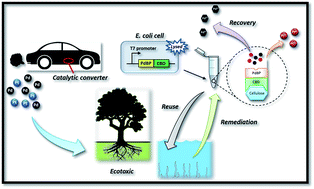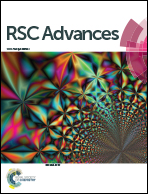Designed biomolecule–cellulose complexes for palladium recovery and detoxification†
Abstract
An efficient, selective and reusable biosorbent is important for precious metal recovery. This paper examines the recovery of palladium Pd(II) from wastewater on designed biomolecule–cellulose complexes. A genetically engineered fusion protein composed of palladium binding peptides (PdBP) and cellulose binding domains (CBD) was expressed in Escherichia coli and enabled the binding of cellulose for palladium recovery and detoxification. The results of this study indicated that the range of pH levels suitable for PdCBD–cellulose complexes is wide and that the effect of temperature on palladium recovery is insignificant. In addition, the PdCBD–cellulose complexes exhibited good reusability and a high selectivity for Pd(II) recovery. The maximum adsorption capacity of the PdCBD–cellulose was 175.44 mg g−1, indicating a high adsorption capacity for Pd(II). The Langmuir adsorption isotherm was applied to describe the processes for removing Pd(II). The kinetics of the Pd(II) removal were identified as following a pseudo-second order rate equation. Furthermore, the results of a Lemna minor growth inhibition test showed effective detoxification of the designed complexes. The results of this study revealed that the designed biomolecule–cellulose complexes can be used to develop a selective process for recovering and detoxifying precious metals.


 Please wait while we load your content...
Please wait while we load your content...